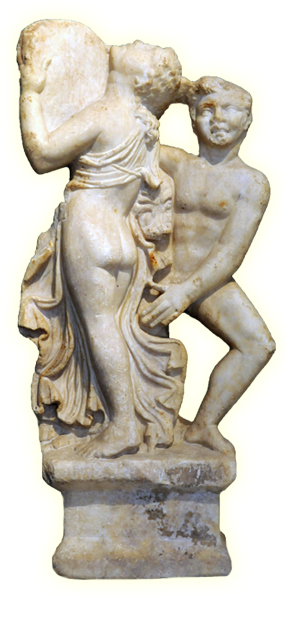Exhibit of the month
Bucolic love …
Trapezophoro (table support) with Satyr and Maenad
National Archaeological Museum
Sculpture Collection, inv. no 2703
Provenance: Found at Gytheio before 1848
Dimensions: Height: 0.76 m
Date: 3rd c. AD
Location of object within the exhibition: Room 33
The trapezophoro (table support) is decorated with the figure of a Satyr who approaches, erotically disposed, a Maenad in ecstasy. The female figure is depicted dancing, playing a tympanum (hand drum), whereas the twirl of her body makes her garment flow, exposing her nudity.
The Satyr who personifies the demonic element and the Maenad who symbolizes the orgiastic forces of nature are associated with the cult of Dionysus and are usually depicted as a hunter and his prey, respectively. The erotic tension of the naked body of the Maenad and the sexual attitude of the Satyr, who is normally depicted ithyphallic, have inspired numerous representations of intercourse between members of the Dionysian thiasos/troupe. The coupling of the god Dionysus himself with Ariadne, the daughter of Minos, following her abandonment by Theseus on Naxos, is a charming variation of these erotic approaches. Moreover, the joined methexis (participation) of the goddess of love Aphrodite with Dionysus offered, according to Lucian (Amores 12 [Erotes]), greater pleasure.
All the other members of the entourage of Dionysus also participate in bacchanalian orgies, such as the Silenoi, mythological demons, who in the Homeric Hymn to Aphrodite (V Y1 ll. 262-263) are described mating in the caves with the Nymphs. On the other hand, goat-footed Pan, the shepherd god, whose main attribute is his eagerness to reproduce, pursues without exception young men, animals, even goddesses and eponymous Nymphs, such as Syrinx and Pitys who, in order to avoid intercourse with him, were transformed into reeds and pine tree, respectively.
Members of marine thiasoi/troupes, such as Nereids and Tritons are also depicted in coupling scenes.
Dr Chrysanthi Tsouli
Suggested bibliography:
Cohon, Greek and Roman Stone Table Supports with Decorative Reliefs, 1984, 450a no 57.
Θ. Στεφανίδου-Τιβερίου, Τραπεζοφόρα με πλαστική διακόσμηση. Η αττική ομάδα, Αθήνα 1993, no 76, pls 38-9.
Α. Stahli, Die Verweigerung der Luste. Erotische Gruppen in der Antiken Plastik, Frankfurt am Mainz 1999, 384 cat. no. 5.
Ν. Καλτσάς, Εθνικό Αρχαιολογικό Μουσείο. Τα Γλυπτά, Athens 2001.


